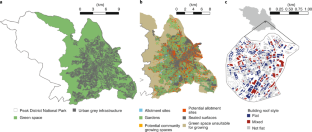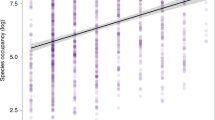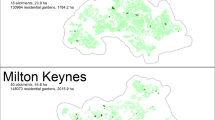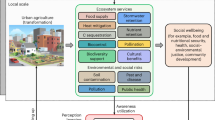Abstract
Urban areas offer considerable potential for horticultural food production, but questions remain about the availability of space to expand urban horticulture and how to sustainably integrate it into the existing urban fabric. We explore this through a case study which shows that, for a UK city, the space potentially available equates to more than four times the current per capita footprint of commercial horticulture. Results indicate that there is more than enough urban land available within the city to meet the fruit and vegetable requirements of its population. Building on this case study, we also propose a generic conceptual framework that identifies key scientific, engineering and socio-economic challenges to, and opportunities for, the realization of untapped urban horticultural potential.
This is a preview of subscription content, access via your institution
Access options
Access Nature and 54 other Nature Portfolio journals
Get Nature+, our best-value online-access subscription
$29.99 / 30 days
cancel any time
Subscribe to this journal
Receive 12 digital issues and online access to articles
$119.00 per year
only $9.92 per issue
Buy this article
- Purchase on Springer Link
- Instant access to full article PDF
Prices may be subject to local taxes which are calculated during checkout


Similar content being viewed by others
Data availability
The datasets generated from GIS analyses using OS Mastermap for areas of green space and flat roofs potentially suitable for urban horticulture identified in Sheffield are available via Mendeley Data (https://doi.org/10.17632/2fscg3m53d.1).
References
Loopstra, R., Reeves, A. & Stuckler, D. Rising food insecurity in Europe. Lancet 385, 2041–2041 (2015).
Zepeda, L. Hiding hunger: food insecurity in middle America. Agric. Hum. Values 35, 243–254 (2018).
68% of the world population projected to live in urban areas by 2050, says UN. UN DESA (16 May 2018); https://go.nature.com/2PBUg00
Mok, H.-F. et al. Strawberry fields forever? Urban agriculture in developed countries: a review. Agron. Sustain. Dev. 34, 21–43 (2014).
Orsini, F., Kahane, R., Nono-Womdim, R. & Gianuinto, G. Urban agriculture in the developing world: a review. Agron. Sustain. Dev. 33, 695–720 (2013).
Morgan, K. Nourishing the city: The rise of the urban food question in the Global North. Urban Stud. 52, 1379–1394 (2015).
UK NEA The UK National Ecosystem Assessment Technical Report (UNEP WCMC, 2011).
Dennis, M. et al. Mapping urban green infrastructure: A novel landscape-based approach to incorporating land use and land cover in the mapping of human-dominated systems. Land 7, 17 (2018).
Casalegno, S., Anderson, K., Hancock, S. & Gaston, K. J. Improving models of urban greenspace: from vegetation surface cover to volumetric survey, using waveform laser scanning. Methods Ecol. Evol. 8, 1443–1452 (2017).
Edmondson, J. L., Davies, Z. G., McHugh, N., Gaston, K. J. & Leake, J. R. Organic carbon hidden in urban ecosystems. Sci. Rep. 2, 963 (2012).
Horticultural Statistics—2018 (Defra, 2019).
Labour Market Profile—Sheffield (ONS, accessed 10 July 2018); https://go.nature.com/2HoHw8t
Output Area to Major Towns and Cities (December 2015) Lookup in England and Wales (ONS, accessed 7 October 2019); https://go.nature.com/2uBQaxR
The Area Based Analysis Unit, Office for National Statistics 1. Understanding patterns of deprivation. Reg. Trends 41, 93–114 (2009).
Smith, D., Thompson, C., Harland, K., Parker, S. & Shelton, N. Identifying populations and areas at greatest risk of household food insecurity in England. Appl. Geogr. 91, 21–31 (2018).
Crouch, D. & Ward, C. The Allotment: Its Landscape and Culture (Five Leaves Publications, 1997).
McHugh, N., Edmondson, J. L., Gaston, K. J., Leake, J. R. & O’Sullivan, O. S. Modelling short-rotation coppice and tree planting for urban carbon management - a citywide analysis. J. Appl. Ecol. 52, 1237–1245 (2015).
Grafius, D. R., Hall, S., McHugh, N. & Edmondson, J. L. How much heat can we grow in our cities? Modelling UK urban biofuel production potential. Glob. Change Biol. Bioenergy 12, 118–132 (2020).
Al-Kodmany, K. The vertical farm: A review of developments and implications for the vertical city. Buildings 8, 24 (2018).
Richardson, J. J. & Moskal, L. M. Urban food crop production capacity and competition with the urban forest. Urban For. Urban Green. 15, 58–64 (2016).
Ackerman, K. et al. Sustainable food systems for future cities: The potential of urban agriculture. Econ. Soc. Rev. 45, 189–206 (2014).
McClintock, N., Cooper, J. & Khandeshi, S. Assessing the potential contribution of vacant land to urban vegetable production and consumption in Oakland, California. Landsc. Urban Plan. 111, 46–58 (2013).
Taylor, J. R. & Lovell, S. T. Mapping public and private spaces of urban agriculture in Chicago through the analysis of high-resolution aerial images in Google Earth. Landsc. Urban Plan. 108, 57–70 (2012).
Martelozzo, F. et al. Urban agriculture: a global analysis of the space constraint to meet urban vegetable demand. Environ. Res. Lett. 9, 064025 (2014).
Joint WHO/FAO Expert Consultation on Diets, Nutrition and the Prevention of Chronic Diseases Technical Report No. 916 (WHO, 2003).
Edmondson, J. L. et al. Feeding a city - Leicester as a case study of the importance of allotments for horticultural production in the UK. Sci. Total Environ. 705, 135930 (2020).
White, J. T. & Bunn, C. Growing in Glasgow: Innovative practices and emerging policy pathways for urban agriculture. Land Use Policy 68, 334–344 (2017).
Baldock, K. C. R. et al. A systems approach reveals urban pollinator hotspots and conservation opportunities. Nat. Ecol. Evol. 3, 363–373 (2019).
Edmondson, J. L., Davies, Z. G., Gaston, K. J. & Leake, J. R. Urban cultivation in allotments maintains soil qualities adversely affected by conventional agriculture. J. Appl. Ecol. 51, 880–889 (2014).
Lin, B. B., Philpott, S. M. & Jha, S. The future of urban agriculture and biodiversity-ecosystem services: Challenges and next steps. Basic Appl. Ecol. 16, 189–201 (2015).
Tablan, V., Roberts, I., Cunningham, H. & Bontcheva, K. GATECloud.net: a platform for large-scale, open-source text processing on the cloud. Phil. Trans. R. Soc. A 371, 20120071 (2016).
Howard, T., Kuri, L. & Lee, I. P. Writing the Next Chapter for Anchor-based Redevelopment Initiatives (Evergreen Cooperative Initiative of Cleveland, Ohio, 2010); https://go.nature.com/3crocWn
Wright, H. C., Zhu, J., Cameron, D. D. & Ryan, A. J. Flexible polyurethane foam with sodium bentonite: Improving the properties of foams for use as a synthetic growing media. Acta Horticult. (in the press).
Dunant, C. F., Dreniok, M. P., Elefheriadis, S., Cullen, J. M. & Allwood, J. M. Regularity and optimisation practice in steel structural frames in real design cases. Resour. Conserv. Recy. 134, 294–302 (2018).
Haberman, D. et al. The potential of urban agriculture in Montreal: A quantitative assessment. ISPRS Int. J. Geo-Inform. 3, 1101–1117 (2014).
Sonnino, R. The new geography of food security: exploring the potential of urban food strategies. Geogr. J. 182, 190–200 (2016).
Milan Urban Food Policy Pact (MUFPP, 2015); http://www.milanurbanfoodpolicypact.org/text
Draft Food and Wellbeing Strategy (Sheffield City Council, 2018); https://go.nature.com/2SreRGh
Maye, D. ‘Smart food city’: conceptual relations between smart city planning, urban food systems and innovation theory. City Cult. Soc. 16, 18–24 (2019).
Bohn, K. & Viljoen, A. The edible city: envisioning the continuous productive urban lanscape. Field 4, 149–161 (2010).
Acknowledgements
This work was supported by the Engineering and Physical Sciences Research Council (EPSRC) under grant nos EP/N030095/1, EPSRC GCRF IS2016 and EPSRC EP/P016782/1, the ISCF Transforming Food Production Award and a University of Sheffield PhDT studentship.
Author information
Authors and Affiliations
Contributions
All authors wrote the manuscript. N.M., D.R.G. and J.L.E. designed the spatial analyses. J.L.E. and J.R.L. designed the SBH research. M.C.D., P.H.W. and J.L.E. investigated the labour involved in allotment-based urban horticulture. D.D.C., G.K.P. and A.J.R. researched CEH foams. V.S. advised on water use. D.O.D.T. provided expertise on building structure. H.C., D.D.C., A.J.R., J.L.E., N.T.B. and J.N. researched CEH.
Corresponding author
Ethics declarations
Competing interests
The authors declare no competing interests.
Additional information
Publisher’s note Springer Nature remains neutral with regard to jurisdictional claims in published maps and institutional affiliations.
Rights and permissions
About this article
Cite this article
Edmondson, J.L., Cunningham, H., Densley Tingley, D.O. et al. The hidden potential of urban horticulture. Nat Food 1, 155–159 (2020). https://doi.org/10.1038/s43016-020-0045-6
Received:
Accepted:
Published:
Issue Date:
DOI: https://doi.org/10.1038/s43016-020-0045-6
This article is cited by
-
Mathematical optimization of frost resistant crop production to ensure food supply during a nuclear winter catastrophe
Scientific Reports (2023)
-
Urban agriculture in walkable neighborhoods bore fruit for health and food system resilience during the COVID-19 pandemic
npj Urban Sustainability (2023)
-
The bright and the dark side of commercial urban agriculture labeling
Agriculture and Human Values (2023)
-
Trait Improvement of Solanaceae Fruit Crops for Vertical Farming by Genome Editing
Journal of Plant Biology (2023)
-
Low presence of potentially toxic elements in Singapore urban garden soils
CABI Agriculture and Bioscience (2022)



